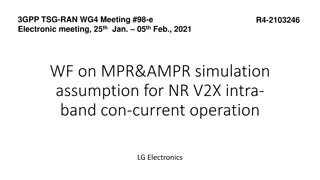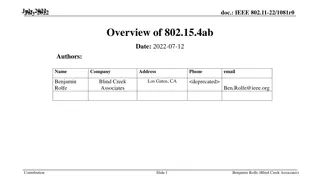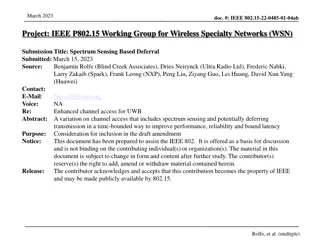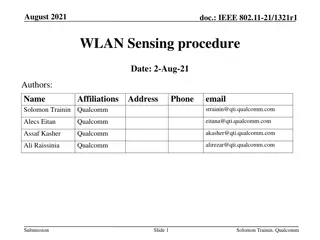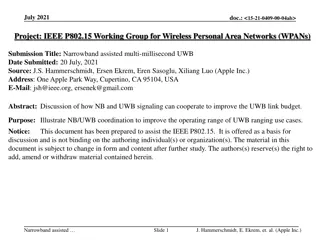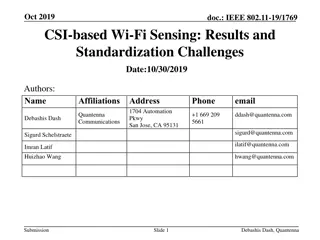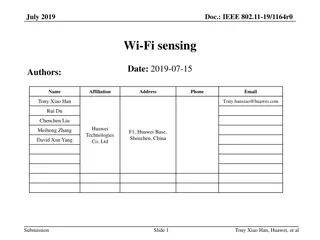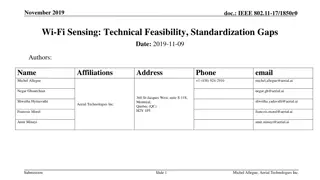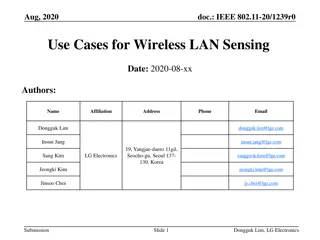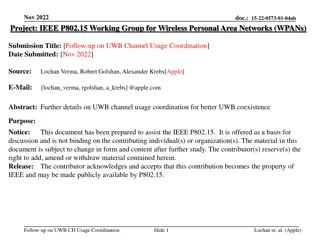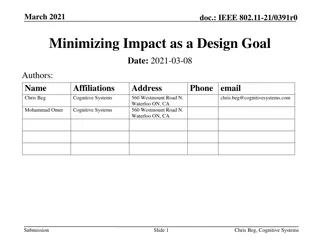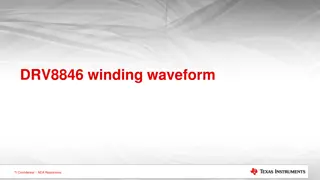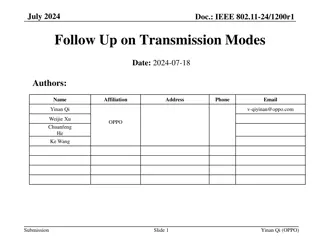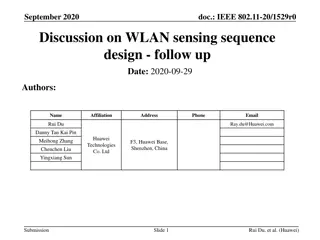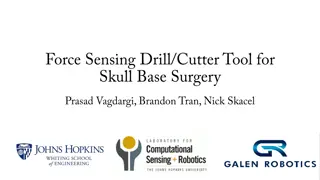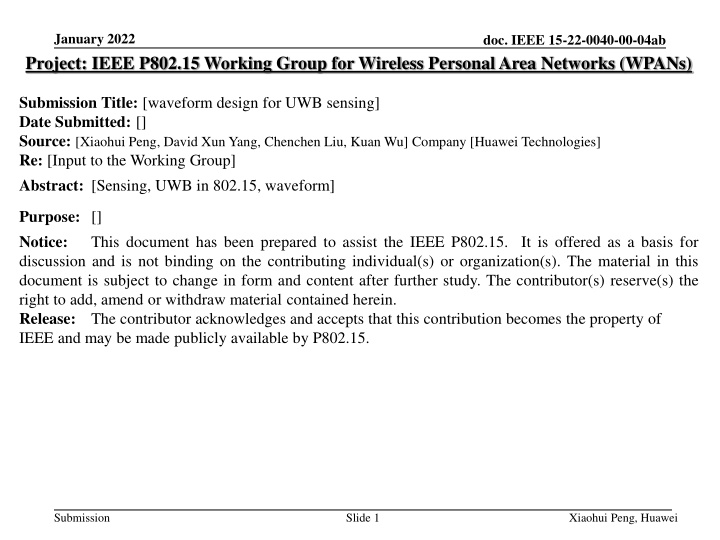
Waveform Design for UWB Sensing in IEEE P802.15 Working Group
"Explore the latest developments in waveform design for Ultra-Wideband (UWB) sensing within the IEEE P802.15 Working Group. The submission discusses safeguarding high throughput data use cases, interference mitigation techniques, coexistence improvements, and backward compatibility with enhanced ranging capable devices. It also covers aspects like improved link budget, hybrid operation with narrowband signaling, sensing capabilities, and infrastructure synchronization mechanisms for wireless personal area networks (WPANs)."
Download Presentation

Please find below an Image/Link to download the presentation.
The content on the website is provided AS IS for your information and personal use only. It may not be sold, licensed, or shared on other websites without obtaining consent from the author. If you encounter any issues during the download, it is possible that the publisher has removed the file from their server.
You are allowed to download the files provided on this website for personal or commercial use, subject to the condition that they are used lawfully. All files are the property of their respective owners.
The content on the website is provided AS IS for your information and personal use only. It may not be sold, licensed, or shared on other websites without obtaining consent from the author.
E N D
Presentation Transcript
January 2022 Project: IEEE P802.15 Working Group for Wireless Personal Area Networks (WPANs) doc. IEEE 15-22-0040-00-04ab Submission Title: [waveform design for UWB sensing] Date Submitted: [] Source:[Xiaohui Peng, David Xun Yang, Chenchen Liu, Kuan Wu] Company [Huawei Technologies] Re: [Input to the Working Group] Abstract: [Sensing, UWB in 802.15, waveform] Purpose: [] Notice: discussion and is not binding on the contributing individual(s) or organization(s). The material in this document is subject to change in form and content after further study. The contributor(s) reserve(s) the right to add, amend or withdraw material contained herein. Release: The contributor acknowledges and accepts that this contribution becomes the property of IEEE and may be made publicly available by P802.15. This document has been prepared to assist the IEEE P802.15. It is offered as a basis for Submission Slide 1 Xiaohui Peng, Huawei
January 2022 doc. IEEE 15-22-0040-00-04ab PAR Objective Proposed Solution (how addressed) Safeguards so that the high throughput data use cases will not cause significant disruption to low duty-cycle ranging use cases Interference mitigation techniques to support higher density and higher traffic use cases Other coexistence improvement Backward compatibility with enhanced ranging capable devices (ERDEVs) Improved link budget and/or reduced air-time Additional channels and operating frequencies Improvements to accuracy / precision / reliability and interoperability for high-integrity ranging Reduced complexity and power consumption Hybrid operation with narrowband signaling to assist UWB Enhanced native discovery and connection setup mechanisms Sensing capabilities to support presence detection and environment mapping Low-power low-latency streaming Waveform design for sensing Higher data-rate streaming allowing at least 50 Mbit/s of throughput Support for peer-to-peer, peer-to-multi-peer, and station-to- infrastructure protocols Infrastructure synchronization mechanisms Submission Slide 2 Xiaohui Peng, Huawei
January 2022 doc. IEEE 15-22-0040-00-04ab Existing waveform for ranging Time domain mask: it is recommended that the pulse should monotonically rise to a first peak amplitude; the first peak amplitude is defined as the maximum amplitude of the pulse before it first drops more than 1.25%. The 8 order Butterworth pulse with a 3dB bandwidth of 500MHz is taken as an example. PSD mask: the transmitted spectrum shall be less than -10dB relative to the maximum spectral density of the signal for 0.65/Tp<|f-fc|<0.8/Tp and -18dB for |f- fc|>0.8/Tp. For example, the transmit spectrum mask for channel 4 is shown as below. Transmit spectrum mask for band 4 [2] Recommended time domain mask for the HRP UWB PHY pulse [1] Submission Slide 3 Xiaohui Peng, Huawei
January 2022 doc. IEEE 15-22-0040-00-04ab Motivation of existing waveform for ranging For ranging application, it focuses on how to accurately measure the timestamp of the earliest path. The reflected path is considered as interference in this case. In order to minimize the impact of the reflected path on the earliest path. so the sidelobe on the left side of the mainlobe is tend to be zero. As you can see in the following map, the peak position of the earliest path is not changed after superposition with the reflected path. The earliest path Reflected path Node B Node A The earliest path and the reflected path Superposition of the earliest path and the reflected path Ranging application Submission Slide 4 Xiaohui Peng, Huawei
January 2022 doc. IEEE 15-22-0040-00-04ab Limitations of existing waveform for sensing For sensing application, it focuses on how to accurately measure the parameters of the reflected path. The earliest path is considered as interference in this case. If we use the same waveform as in the ranging application, the sidelobe of the earliest path will affect the amplitude of the reflected path. As you can see in the following map, the peak position of the reflected path is changed by the sidelobe of the earliest path, which will lead to a wrong estimation of the reflection point. The earliest path Node B Reflected path Node A Reflection point1 Superposition of the earliest path and the reflected path The earliest path and the reflected path Sensing application Submission Slide 5 Xiaohui Peng, Huawei
January 2022 doc. IEEE 15-22-0040-00-04ab Ambiguity function In radar signal processing, an ambiguity function is a two-dimensional function of propagation delay ? and Doppler frequency f, ??(?,?). It represents the distortion of a returned pulse due to the receiver match filter of the return from a target. For a given pulse s(t), the ambiguity function is given by: + ? ? ? ? ? ???????? ?? ?,? = Where * denotes the complex conjugate. Two dimensional ambiguity function Zero-Doppler cut of the ambiguity function Submission Slide 6 Xiaohui Peng, Huawei
January 2022 doc. IEEE 15-22-0040-00-04ab KPIs of the sensing waveform Resolution The resolution is defined as the -3dB width of the mainlobe, which indicates that two targets are distinguishable if their range difference is greater than this -3dB width. The resolution is inversely proportional to the bandwidth ? = ?/?, where c is the speed of light and B is the bandwidth. -3dB width Peak sidelobe ratio Sidelobe level The main cause of ringing artifacts is due to a signal being band-limited. The sidelobe ratio, usually expressed in decibels (dB), of the amplitude at the peak of the mainlobe to the amplitude at the peak of the sidelobe. PSD mask The sensing waveform should have a spectrum comply with the PSD mask defined by 802.15.4z [3]. Submission Slide 7 Xiaohui Peng, Huawei
January 2022 doc. IEEE 15-22-0040-00-04ab Analysis of sensing waveform -3dB -14.37dB Here, 8 order Butterworth pulse is taken as an example to analyze the sensing performance. From the result we can see that the 3dB resolution is about 1.6ns, and the PSLR (peak sidelobe ratio) is about -14.73dB. Submission Slide 8 Xiaohui Peng, Huawei
January 2022 doc. IEEE 15-22-0040-00-04ab Waveform after applying window Pulse after applying window pw(t)=p(t)*g(t) Gaussian pulse g(t) 8th order Butterworth pulse p(t) Here, in order to reduce the sidelobe of the pulse, we applying a Gaussian window to the 8th order Butterworth pulse and get a new pulse with reduced sidelobe level. The new pulse also comply with the PSD mask. Pulse power density spectrum Submission Slide 9 Xiaohui Peng, Huawei
January 2022 doc. IEEE 15-22-0040-00-04ab Analysis of the waveform after applying window -14.37dB -23.26dB The waveform after applying the Gaussian window has the same range resolution as the 8th Butterworth pulse, but the waveform has a -23.26dB PSLR which is 8.89dB lower than that of the 8th Butterworth pulse. Both waveforms can comply with the time and PSD mask given by 802.15.4z, but these two waveforms have different PSLR which is important for sensing applications. In addition to the time and PSD mask, other constraints should be considered for sensing waveform. Submission Slide 10 Xiaohui Peng, Huawei
January 2022 doc. IEEE 15-22-0040-00-04ab Summary First, we introduced the waveform used for ranging application and pointed out its limitation for sensing application. Then, the ambiguity function is used to evaluate the performance of the sensing waveform. Lastly, we analyze the sensing performance of two waveforms that both comply with the time and PSD mask given by 802.15.4z, but these two waveforms have different PSLR which is important for sensing application. In addition to the time and PSD mask, other constraints (e.g. ambiguity function mask or time-domain mask with lower side lobe) should be considered for sensing waveform. Submission Slide 11 Xiaohui Peng, Huawei
January 2022 doc. IEEE 15-22-0040-00-04ab References 1. Amendment1: Enhanced ultra wideband (UWB) physical layers (PHYs) and associated ranging techniques 2. IEEE standard for low-rate wireless networks 3. UWB spectral mask and FFC part 15 limits Submission Slide 12 Xiaohui Peng, Huawei



